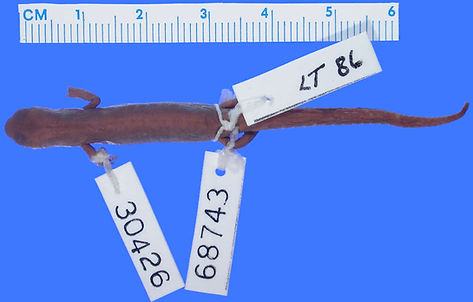Creature
Fast Facts
Introducing you to extinct species.

THE JALPA FALSE
BROOK SALAMANDER
1. The Jalpa false brook salamander, Pseudoeurycea exspectata, was native to Guatemala. 2. It is closely related to the critically endangered Goebel's false brook salamander of Mexico & Guatemala. 3. Their stomachs were a dark gray blue and their backs were reddish-brown. 4. The tail had a lighter topside, lacking the marbling under their tail. 5. The Jalpa false brook salamander had a bulky body, short blunt snout, and darker legs than its close relative. 6. The Jalpa false brook salamander lived in the broadleaf forests of Cerro Miramundo at an elevation of 8,284 feet. 7. They preferred living in rotten logs, damp leaf litter, or abandoned beetle burrows. 8. Although common at the time, only one specimen was ever collected on March 21, 1952 by herpetologist Laurence Cooper Stuart, 9. Two years later, in 1954, it was formally named and described. 10. 18 trips to the region have failed to produce any further specimens. 11. It was formally declared extinct in August of 2018.
Extinction
Cometh
Facing the light at the end of the tunnel
EXTINCTION DATE
1976
The Jalpa false brook salamander is one of three known extinct salamander species. The Ainsworth's salamander (which may or may not be a distinct species) and the Yunnan Lake newt are the other two. Many other salamanders may be extinct but are still listed as critically endangered. Laurence Cooper Stuart first collected a Jalpa false brook salamander in Guatemala on March 21, 1952. He formally named and described it two years later in 1954. During the initial discovery it was considered common in the broadleaf forest west of Cerro Miramundo. Its habitat was altered by logging and the introduction of farming in the area. Its number quickly plummeted. Ten trips between 1985 - 2000 to locate the salamander yielded no specimens. After eight more surveys between 2005 - 2018 also provided no evidence of its existence, the Jalpa false brook salamander was formally declared extinct in 2018. Although Jurassic Park is fiction, scientists are working on several de-extinction projects. In fact, in 2003 scientists did bring back the extinct Pyrenean ibex, a type of wild goat, for 7 minutes before it died, showing de-extinction is possible. The Jalpa false brook salamander might be a candidate. Scientists would potentially use DNA from the single known specimen. It could then be protected until its native forests and habitat are restored. If the Jalpa false brook salamander was brought to life, could it ever be reintroduced to its native homeland in the volcanic, broadleaf forests in Guatemala?
COMING SOON
The Jalpa false brook salamanders's Lazarus tale has yet to be written, but what adventures will await it when it returns to the Guatemala? Stay tuned to find out.
More to Explore
All answers lead to more questions
.jpg)
Stuart photo from 1954 of the only Jalpa false brook salamander collected.
Image from Encyclopedia of Life
VIDEOS & ADDITIONAL INFO
10 Extinct or Nearly Extinct Amphibians
Brave Wilderness - Poisonous Newt Video
PBS - Wildlife Journal Junior - Facts on Salamanders
Maryland Zoo - Panamanian Golden Frog

A photo of the closely related & critically endangered, Goebel's false brook salamander, that lives in Mexico & Guatemala.
Image from Cal Photos, Berkeley


Guatemala geography flag
Image from Fine Art America
Guatemala geography map
Image from Southwind Adventures

Book about extinct amphibians
Image from Amazon

Nearly half of amphibians are threatened
Image from nzfrogs.org

Status of the world's salamander species
Image from Monga Bay

Ainsworth's salamander is one of two other "extinct" salamander species, but the holotype (one specimen collected) was unable to be tested to definitively prove a unique species.
Image from Encyclopedia of Life



